The Vendel Era
Helgö, an island in Lake Mälaren, is an ancient site of trade, and therefore also craftsmanship. Crucibles, fragments of molds, and iron slag show that bronze and iron were shaped here, probably for export. Helgö’s heyday was during the Vendel Era, about 500–800 AD. Archeological digs here since the 1950s have turned up huge amounts of iron objects, including many keys and parts of locks.
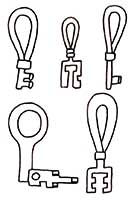 |
| Reconstructed iron keys from Helgö, 8th–9th C. They were used in turnkey locks and push-key locks. Sketch by the author. |
In the transition from the Vendel Era to the Viking Era, several new forms appeared. The main change is in the shape and decoration of the bow. The most common shape was oval, though round bows were also common. They were decorated with animals and solid or openwork plant motifs.
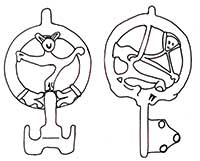 |
| Bronze keys from the southern province of Skåne, 8th–9th C. They were used in turnkey locks and push-key locks. Sketch by the author. |
Viking keys meant power
Married women had a very strong position in the Viking Era, and keys helped express this. When a couple was married, the wife was given a set of keys to symbolize her new status – “given to lock and key,” as it was called. The shiny bronze keys hung in full sight on her clothing, along with a small knife or a pair of scissors.
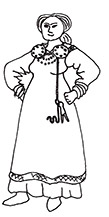 |
| Woman with key power. Sketch by the author. |
The ancient book of Scandinavian mythology, the Edda, clearly states that the key chain belonged to the woman’s costume. When Thor’s hammer was stolen by the giants, the disguise he used to steal it back was a bridal gown – with a bunch of rattling keys.
The trade city of Birka
When Helgö declined in the 9th century, the city of Birka arose. Just 10 km away from Helgö, Birka had a coast that offered a deeper harbor, a necessity for seafaring ships. Historians believe that this is the reason for the rise of Birka: a desire for international trade. Birka’s location also gave it better conditions to grow into a city.
Archeological digs since the late 19th century have turned up large amounts of keys, locks, and parts of locks. Birka also saw a new kind of key that did not exist in Helgö – push keys, which were used in padlocks with trapezoidal housings and detached shackles with wards. The keys have flat bits with notches for the guide pins and ward springs. By the end of the Viking Era, turning keys were also used in these locks.
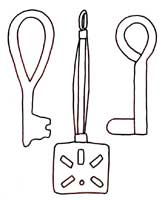 |
| Bronze and iron keys from Birka. They were used in turnkey locks and push key locks. Sketch by the author. |
Gotland
Thanks to its strategic location, the Baltic island of Gotland became very important to Sweden. The island was populated as early as the Stone Age. In the 5th century, locals began carving picture stones, which are unique to Gotland. They continued making stone monuments until the 12th century. The island was a vital part of Baltic trade from an early era, and crafts shops cropped up anywhere that trade occurred. The famous trade city of Visby was founded in the 11th century. Archeologists throughout the 20th century have found tons of bronze and iron keys in all the known Viking-Era styles on Gotland. These finds also show that key shapes could vary greatly for the same type of locks.
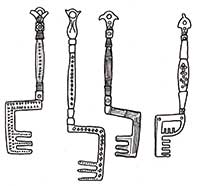 |
| Bronze keys from Gotland, 8th–9th C. These keys were intended for chests and boxes. Sketch by the author. |
The majority of the keys come from women’s graves. They represent a range of different types, made of iron, bronze, or a combination.
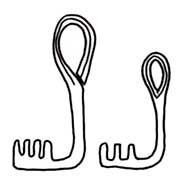 |
| Bronze keys from Gotland, about 1000 AD. These keys were intended for chests and boxes. Sketch by the author. |
Most of the finds are bronze or iron keys with two bends, which were used in the latter Viking Era.
 |
| This type of iron or bronze keys with two bends were common throughout Scandinavia and were intended for chests and boxes. Sketch by the author. |
 |
Two Viking-Era keys from the Historical Museum of Gotland. The key with the anchor-shaped bit is 26.2 cm long and was used for locks with wooden tumbler pins.
The other is 15.4 cm long and has the same function. Sketch by the author. |
Push keys and keys for padlocks with shackles and ward springs have also been found from this period. Iron keys (turning keys) first came into use in the 10th century. No iron keys have been found in combination with bronze ones in grave finds.
Viking-Era keys in Småland
The Museum of National Antiquities in Stockholm has eight Viking-Era keys with a uniform look, all from archeological digs in the Värnamo region of Jönköping County in southern central Sweden. Another four keys from the same region are preserved at the Jönköping County Museum. These twelve keys, along with one found in Halland County, two from Kalmar County, one from Skåne, and three from the island of Bornholm, form a uniform and thus far undocumented group. All have an S-shaped bit and are forged out of iron.
 |
| Push key from Gudhjem on the island of Bornholm. Sketch by the author. |
Visingsö
Visingsö is a long narrow island of about 12 km long in the middle of Lake Vättern, Sweden’s second-largest lake. The island was the seat of royal power from the 12th century to about 1300. Three grave fields of Iron-Age (Viking) graves are found on the island. On the easternmost of the two capes on the southern tip of the island lies the fortress of Näs.
 |
| Bronze key from the Viking Era. Sketch by the author. |
Archeological digs in the northern grave field, near the Kumlaby Church, in 1900–1910 turned up a bronze key along with a bronze ring, glass beads, bone combs, bronze brooches, and more. The key, whose shaft is ornamented with openwork band patterns, has been dated to 800–1000 (the Viking Era).